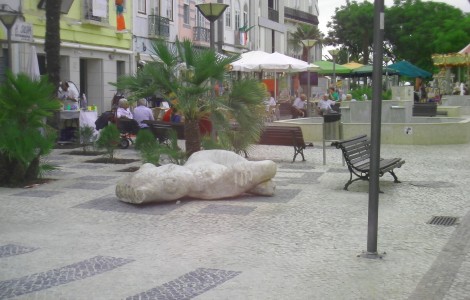 Lagos is a city with culture, everyone says. In any case, the history (more or less whitewashed) of a city of the Discoveries was propagated. Perhaps millions were invested in initiatives to promote a fetish brand they called Lagos dos Descobrimentos.
Lagos is a city with culture, everyone says. In any case, the history (more or less whitewashed) of a city of the Discoveries was propagated. Perhaps millions were invested in initiatives to promote a fetish brand they called Lagos dos Descobrimentos.
But Lagos is more than that. It is also proclaimed a city of artists and some of the History of Portuguese Art was built in it. In the last decades of the 1982th century, some artists settled there who looked at a city that offered some charm and where people's human potential allowed them to dream. One of these dreams resulted in the Bienais de Lagos, a competition born in 90 by the hands of a group of artists with the help of the Portuguese army, and with a death certificate signed in the XNUMXs by the local authority in Lacobrigense.
A death that had a new life as its reverse, the Centro Cultural de Lagos. In this space, many people have dreamed and in it, with more or less means, it was possible to erect ideas and processes that, although not always happy, marked longer moments or times. A space that is currently lifeless, keeping its doors open pretending to have a schedule, but the fragility of its program is broken with the first wind that comes from the sea.
The sea, this one, calmly watches this collapse. You know that it has been the object of dreams, theories and a lot of creation. It draws inspiration from many works of art, as well as monstrous attacks that, in defense of the city's return to the sea, present architectural orgasms such as the current disfigured Praça do Infante.
In the 60s, when the riverfront was restructured, another square was born, which, although motivated by a Estado Novo framework that looked at art hostage to a monumental history, articulated a space with life and left us a very important legacy that more recent times have come to tear. On this subject I have already had the opportunity to write an article published in Jornal Barlavento (read here), but it is worth continuing to reflect and question.
What plan does the municipality of Lagos have for the preservation of public art in the city? I am left without an answer and a certainty: the plans here are only made when it is possible to approve interventions that threaten the free use of public space, such as the castrant transformation in Meia-Praia and the future intervention of Porto de Lagos, that intervenes in the future in favor of a Marina insensitive to cultural issues, with notorious real estate interest and little desire to produce social return through the use of what belongs to us.
The public space in Lagos, as well as its art, has not been considered, either because of the lack of treatment or because there are poorly done treatments, cooked in the cabinets in vertical systems that kill any possibility of building a fair and participatory society.
We are used to seeing our artistic objects intervened in alarm, with serious gaps in the care that should be taken when deciding to requalify or renovate our heritage.
Recently recovered, the sculpture by artist Jorge Vieira next to the courthouse is a good example of the lightness with which it is decided to revive colors with a tacky enamel and without the thoroughness and rigor in its application.
In the same area, there is a renovation of the pavement in the downtown area, removing the decrepit green spaces and replacing them with sidewalks and terraces. In it we find a sculpture by João Cutileiro that appears in the city's public art script and which was treated in this intervention without the slightest respect, with ailments that are marked in its marble skin. It's just that moving a stone sculpture is not the same as moving a boulder and the City Council has an obligation to know that.
The statue of D. Sebastião located in Praça Gil Eanes and by the same author, is today a reference in Portuguese statuary, having been developed in stone modules that build a king that generated a strong discussion in the society of Fine Arts when, in 1973, has been implemented.
Currently with one of the arms hanging from the body, its maintenance is imperative not only for its conservation, but also for public safety, since it is at risk of falling and taking with it one of the countless tourists who, arm in arm with the statue, take photographs. The leaders, these, have long been warned, and are currently responsible if any disaster happens.
Nothing to do! A comfortable position that is in keeping with the times. The inert people, undaunted and serene, witness an unprecedented assault, while their built and immaterial heritage sinks.
They are winds of a salty malady that can be found in many other cities, eroding heritage under the policies of ignorant central governments, such as the current one, which signed a treaty of culture annihilation in a royal charter, choosing as executioner of its execution the writer who is now playing politics and who will know little about what is happening in this country.
Oh Lagos, oh Portugal!



















Comments